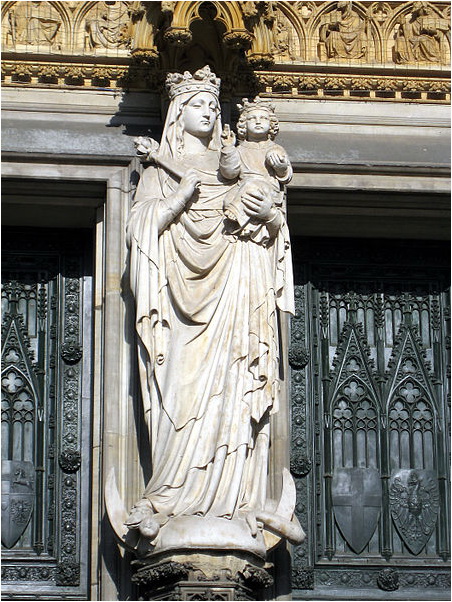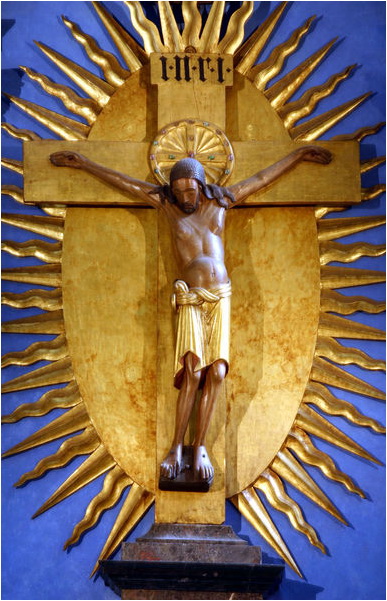 Cologne Cathedral Sculpture Cologne Cathedral Sculpture
Exterior Sculptures
In the exterior remarkable
gargoyles and corbel figures have survived from the time of
the building’s construction, but the only medieval portal is
the St Peter Portal on the west side of the south
tower.
It has figures of exceptional quality
on the jambs and archivolts, some of which have been attributed
to Heinrich von Gmünd.
Slightly earlier figures and fragments
of baldacchini and gables have survived on the south
tower.
In the 19th century all nine portals
were furnished with sculpture. Some of those
destroyed in World War II were replaced c.1955.
Interior
Sculptures
 Inside the cathedral are stone figures on the choir piers
representing Christ, theVirgin and the twelve Apostles.
Inside the cathedral are stone figures on the choir piers
representing Christ, theVirgin and the twelve Apostles.
They are around 2 m high and stand under baldacchini about 5 m from the floor.
Except for those of Christ and the Virgin, the baldacchini are surmounted by music-making
angels.
The figures were made in the cathedral workshop, and the style follows the latest
French models, especially that found at the Sainte-Chapelle, Paris.
The richly patterned drapery was renewed in the 19th century, based on the medieval
remains. The Cologne cathedral choir contains an exceptionally well-preserved collection of
medieval furnishings.
The huge Gero Crucifix made of oak in the Kreuzkapelle, brought from the old
cathedral, is the earliest extant life-size statue since antiquity and was the model for
numerous medieval crucifixes. The oak choir-stalls made between 1308 and 1311 have 104 seats and
are the work of both the cathedral workshop and a Paris workshop.
Some stylistic influence from Lorraine is also perceptible, and this is even more
marked in the contemporary marble figures of saints on the high altar, made by Lotharingian
sculptors working with craftsmen from Cologne and Paris.
Despite employing specialist sculptors for the
choir-stalls and high altar, however, the cathedral workshop
was still able to develop a style of its own that left its
mark on sculpture in Cologne until beyond the middle of the
14th century.
Some of the original medieval furnishings of
the choir were destroyed in the 18th century and
rediscovered in excavations; these include fragments of
sculpture from the choir portals, stone celebrant’s chair
and reading platform.
Like the architecture of the choir screen
they were painted in brilliant azurite, vermilion and
gold. The Late Gothic tabernacle, probably made by the
sculptor Franz Maidburg, was also demolished in the 18th
century; two reliefs are preserved in the Schnütgen-Museum,
Cologne.
Many medieval sculptures survive in the
choir ambulatory and chapels. The workshop that produced the
choir-pier figures also made the Virgin of Milan, which
replaced a figure of the Virgin brought from Milan by
Archbishop Rainald von Dassel together with the bones of the
Three Kings, for which the great shrine was made.
The chapels also contain the tombs of many of the Archbishops of Cologne.
Each is related to an altar, and their arrangement is indicative of the political
iconography of the cathedral choir. The bronze tomb of the cathedral’s founder, Konrad von
Hochstaden, which originally stood in the axial chapel, is the earliest monument from the Gothic
cathedral. It must have been made shortly after the death of the archbishop, and reflects the style
of the transept portals of Notre-Dame, Paris.
|

